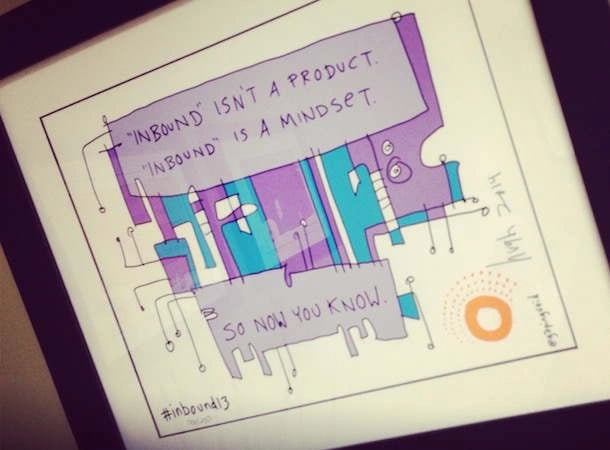

Many things in life and business are misunderstood and under-appreciated. Professional athletes make playing a sport look easy but you don't see the hundreds of hours of training that occurred behind the scenes. After all, it's just putting a ball in a hoop, right? Attorneys often just get a few minutes to make their case in court but no one else sees all the behind the scenes work that goes into that short presentation.
After all, it's just asking a bunch of questions, right? Building an app can look simple but if you knew how much planning and coding occurred behind the scenes it would blow your mind. After all, it's just putting a few screen together and writing a little bit of code, right?

The point is, as an onlooker it can be easy to make snap judgments about professions or industries simply because we don't know enough about them. Marketing is no exception and in fact it can be one of the most easily misunderstood areas of business.
More specifically, inbound marketing is a frequently misunderstood area of business that has developed a few myths. These myths are often repeated by others without proper exploration or background information.
So how do we clear up some of these myths? Let's look at what they are...
1) Inbound marketing is basically just putting white papers on your website
I've often talked to well-meaning marketing directors and CEOs who think they are doing inbound marketing. When I ask them about it they say "yeah, we have some white papers on our website and we're gathering email addresses with them. We're doing inbound marketing!"
Hold on there, sport. While publishing offers is one segment in a list of potential tactics, it is by far not the entire picture. There is research, SEO strategy, creative thinking, careful analysis of writing and content, lead scoring, CRM integration, sales process engineering, workflow analysis, design and usability decisions, a variety of content formats, social media placement, testing and metrics, and a whole slew of other things. It goes way beyond publishing a few white papers.
2) Inbound marketing is the "new term" for SEO
Marketing terminology can change a lot so it's understandable that people might thing that inbound marketing is just a new way to say SEO. Actually, SEO is a component of inbound marketing.
SEO involves bringing qualified visitors to your website through search. Inbound marketing is the holistic practice of earning traffic, turning that traffic into leads, and turning leads into sales. SEO is very important to the traffic part of the equation but it is not the same thing.
3) Inbound marketing is a fad and will soon go away
It's easy to dismiss trends in marketing, technology, and business as "fads" and ignore them. However, did you know that inbound marketing is actually an evolved form of a marketing strategy that has been around for ages? Think of the core strategy of inbound marketing: provide value and utility to your prospects, make yourself visible, earn trust, and earn the sale. Does that sound like a form of marketing that has withstood the test of time? Inbound marketing simply a more scalable, efficient, and modern way of approaching the market with the same intent.
4) Inbound marketing means my phone will be ringing off the hook with prospects wanting to buy things
Because marketers are an optimistic and enthusiastic bunch, some people (understandably) have a slightly unrealistic expectation of what inbound marketing can do. They think that it means they will never have to prospect or reach out to people. Sales teams have dreams of all prospects coming to them without any coaxing at all.
What a dream world that would be! In reality, a well-planned and well-executed inbound marketing program brings in both active and passive leads. Active leads do tend to increase but the sales team still needs to reach out to passive leads to start a relationship. The good news is that these leads are much more qualified, much more engaged, and have a higher chance of closing. Sales teams also have a lot more data on these prospects which can help them be more efficient and effective.
5) If I do inbound marketing I don't need to do anything else
Just like in the previous myth, some people feel that inbound marketing should do everything for them. While it can be the most efficient and most significant part of your business growth strategy, we do recommend supplementing it with other methods as long as they are working.
For example, we will network, ask existing clients for referrals, and do the occasional conference because we have a plan to tie them all into our inbound marketing program.
6) Inbound marketing can be done by one person (like my marketing director)
Oh boy. This one is big. We often see CEOs get really excited about the possibility of growing their business with inbound marketing (which is great!) but they end up having a somewhat unrealistic expectation of how to execute the program. They either want to hire a person to do it all or they dump the entire program on their marketing director (or manager/coordinator) and expect them to do it all.
Truth: inbound marketing is many skill sets in one. It's SEO, social media, content writing, design, development, strategy, project management, data analysis, business thinking, audio/video production, just to name a few. It's virtually impossible for one person to have the time or the skill to handle everything.
If you're going to implement an inbound marketing program, you need a team. That team can either be in-house or it can be from an inbound marketing agency but it takes more than one person.
7) Inbound marketing can be done without paying a lot for expensive software
Some people hate paying for software fees. When we talk about the benefits of inbound marketing and the value that comes with it they get really excited but as soon as we talk about paying for software, they get really resistant.
Can you execute an inbound marketing program without "expensive" software? Yes. But you will struggle to gain traction because there will be so much friction in the process. It might sound scary to commit to $1,000/month for software (like HubSpot) but when your results come faster and you've made six figures in sales as a result of the program, you won't care how much the software costs.
8) Inbound marketing works for every kind of business
You might be surprised to hear that we don't recommend inbound marketing for every type of organization. We are always looking for the right solution for the right organizations. We often refer people to other agencies or steer them toward other programs because we know that inbound marketing is not a fit for them.
Since inbound marketing takes a lot of time, effort, and money, it is best suited for organizations that sell an expensive product or service. Some examples include health care, professional services, manufacturing, financial services, and software companies. These types of organizations can quickly see an ROI with just a few more sales. On the flip side, a local restaurant selling $25 dinner specials is probably never going to see ROI from inbound marketing.
9) Inbound marketing is the same thing as content marketing
Just as SEO is not the same thing as inbound marketing, neither is content marketing. Again, content marketing is a subset and a huge component but it is not everything. Content marketing means producing solution-oriented content for your audience, which can result in search and social media visibility. But inbound marketing goes deeper and is a comprehensive lead generation system.
10) Inbound marketing is a formula to execute
Our final myth may be the most important. Some people think that inbound marketing is a checklist of things to execute. Start a blog? Check! Post once a week? Check! Publish a white paper? Check! Call some leads? Check!
Boring!
While there is a general structure to this method of marketing and there are specific commonly-used tactics, it is far from formulaic. As the image earlier in this post says "inbound isn't a product, inbound is a mindset."
It's a cultural shift. It's a commitment to focusing on your customer/client, not you. It's a focus on creating a business that matters. It's a decision to be a human business that shows personality. It's the idea of being (sometimes frighteningly) transparent. It's building your business around sincerely helping people. It's about marketing with heart. When this is your mindset, the tactics become easy.
What are your favorite inbound marketing myths?




![How to Delete Your Instagram [Easy Guide]](https://blog.hubspot.com/hubfs/delete-instagram.png)
![Millennials vs. Gen Z: Why Marketers Need to Know the Difference [New Data]](https://blog.hubspot.com/hubfs/millenials%20vs%20gen%20z%20what%20marketers%20need%20to%20know%20when%20trying%20to%20reach%20each%20generation.jpg)

![How to Edit a PDF [Easy Guide]](https://blog.hubspot.com/hubfs/280_How-to-Edit-PDF.png)

![Marketing Without a Budget? Use These 10 Tactics [Expert Tips]](https://blog.hubspot.com/hubfs/marketing%20without%20budget.jpg)
